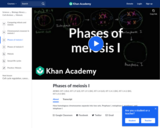
See how an X or Y chromosome carried by a sperm cell, determines the sex of the offspring in this video. [5:52]
- Subject:
- Science
- Material Type:
- Audio/Video
- Provider:
- Howard Hughes Medical Institute
- Provider Set:
- BioInteractive
- Date Added:
- 10/01/2022

See how an X or Y chromosome carried by a sperm cell, determines the sex of the offspring in this video. [5:52]

Biology 2e is designed to cover the scope and sequence requirements of a typical two-semester biology course for science majors. The text provides comprehensive coverage of foundational research and core biology concepts through an evolutionary lens. Biology includes rich features that engage students in scientific inquiry, highlight careers in the biological sciences, and offer everyday applications. The book also includes various types of practice and homework questions that help students understand—and apply—key concepts. The 2nd edition has been revised to incorporate clearer, more current, and more dynamic explanations, while maintaining the same organization as the first edition. Art and illustrations have been substantially improved, and the textbook features additional assessments and related resources.


By the end of this section, you will be able to do the following:
Explain that meiosis and sexual reproduction are highly evolved traits
Identify variation among offspring as a potential evolutionary advantage of sexual reproduction
Describe the three different life-cycle types among sexually reproducing multicellular organisms.

By the end of this section, you will be able to do the following:
Describe the behavior of chromosomes during meiosis, and the differences between the first and second meiotic divisions
Describe the cellular events that take place during meiosis
Explain the differences between meiosis and mitosis
Explain the mechanisms within the meiotic process that produce genetic variation among the haploid gametes

By the end of this section, you will be able to do the following:
Explain Mendel’s law of segregation and independent assortment in terms of genetics and the events of meiosis
Use the forked-line method and the probability rules to calculate the probability of genotypes and phenotypes from multiple gene crosses
Explain the effect of linkage and recombination on gamete genotypes
Explain the phenotypic outcomes of epistatic effects between genes

By the end of this section, you will be able to do the following:
Discuss Sutton’s Chromosomal Theory of Inheritance
Describe genetic linkage
Explain the process of homologous recombination, or crossing over
Describe chromosome creation
Calculate the distances between three genes on a chromosome using a three-point test cross


Biology is designed for multi-semester biology courses for science majors. It is grounded on an evolutionary basis and includes exciting features that highlight careers in the biological sciences and everyday applications of the concepts at hand. To meet the needs of today’s instructors and students, some content has been strategically condensed while maintaining the overall scope and coverage of traditional texts for this course. Instructors can customize the book, adapting it to the approach that works best in their classroom. Biology also includes an innovative art program that incorporates critical thinking and clicker questions to help students understand—and apply—key concepts.

This 27-minute video lesson looks at the phases of Meiosis. [Biology playlist: Lesson 11 of 71].
Khan Academy learning modules include a Community space where users can ask questions and seek help from community members. Educators should consult with their Technology administrators to determine the use of Khan Academy learning modules in their classroom. Please review materials from external sites before sharing with students.

This 14-minute video lesson covers the chromosomal basis for gender and sex-linked traits. [Biology playlist: Lesson 17 of 71].
Khan Academy learning modules include a Community space where users can ask questions and seek help from community members. Educators should consult with their Technology administrators to determine the use of Khan Academy learning modules in their classroom. Please review materials from external sites before sharing with students.

Paul Andersen details the first 7 of 13 labs in the AP Biology Curriculum. The following topics are all covered: Artificial Selection, Hardy-Weinberg Equilibrium, Comparing DNA using BLAST, Diffusion and Osmosis, Photosynthesis, Respiration, Mitosis and Meiosis. [13:26]

This pathway provides an introduction to the cell cycle and how its regulation is important to normal cell division. Cancer is often caused by unregulated cell division. For a deeper look at this topic, we recommend the pathway Cell Reproduction from the OpenStax textbook Biology for AP® Courses.

This pathway explores division of cells through mitosis and meiosis and how disregulation of these processes can lead to disease.

Theodore Boveri will describe his research with worms that helped him discover the principles of meiosis. The animations of meiosis are really good.

Animated activity offers a simple look at meiosis and the production of gametes for reproduction. The stages are well animated and then students can put the gametes together to make baby dragons to illustrate how different they can be. Note that the sex chromosomes in this activity are based on those found in birds and are not reflective of the chromosomes that determine sex in mammals.

The Geniverse software is being developed as part of a five-year research project funded by the National Science Foundation. Still in its early stages, a Beta version of the software is currently being piloted in six schools throughout New England. We invite you to try the current Beta version, keeping in mind that you may encounter errors or pages that are not fully functional. If you encounter any problem, it may help to refresh or reload the web page.